 It will be my endeavour to keep the description as crisp as possible, the idea here is to empower you with enough information to choose and savour wines. Wine is a fermented beverage made out of grapes. Well it can be made from anything that has sugars but for anything other than grapes, the ingredient goes as a prefix. For e.g Plum wine, Pineapple wine, Rice wine. So when we just say wine it is understood that it is made from grapes. Types of Wine: 1. Red/Rosso/Rouge Made out of black grapes; these wines can come in a spectrum from very light bodied to highly robust wines. These wines are consumed between 12-18 degrees celsius. This is the European room temperature. So always leave your reds in the refrigerator for some time in India. 2. White/Blanco/Bianco These can be made out of white or black grapes. A white wine from a Black grape? Yes because in a black grape only the skin is coloured but the juice is not. So how does a Red wine get its colour? The skins are soaked in the juice for a day or two to extract colour and that is how.White wines are consumed at temperature ranging from 8-12 degree celsius, based on the style of wine. 3. Rose/Blush/Rosado These are in-between whites and reds; the pink colour is obtained by soaking the skins for some hours. These wines are again are consumed at 8-10 degree celsius. 4. Sparkling/Fizzy The above three types are together called as still wines as these wines do not have trapped carbon-di-oxide and the fizzy wine does. C02 is a by-product of fermentation in still wines it is released and in sparkling it is not. When poured in a glass it the bubbles or the mousse give it a sparkling appearance. You can easily distinguish these wine bottles by their shape which is distinctly different from still wines. Have them chilled; if you want a number then it is 4-6 degrees. Champagne is the most famous sparkling wine. 5. Fortified Fortified because these wines are fortified with spirit and hence the alcoholic percentage of these is anywhere from 16-22 % v/v. They may or may not be sweet, but all of those readily available over the counter in India are sweet ones. The famous ones are Port from Portugal (Port from Goa is an Irony!), Sherry from Spain. Let us look at some popular grape varieties and their pronounciations Red Cabernet Sauvignon Ca-bur-neh So-vi-ni-yon Red Merlot Mer-lo Red Shiraz or Syrah Shiraz…no complications White Sauvignon Blanc So-vi-ni-yon Blon White Chenin Blanc Che-nin Blon White Viognier Vi-yo-ni-eh White Semillon Se-me-yon Common wine terms to begin with: A dry wine: Wine with very less sugar, to put a number; it is less than 6gms per litre of wine as opposed to a sweet which is more than 50 gms. The ones between the ends are called off-dry, semi-dry. Many time people get awestruck by the sweet-smelling aromas from the wine and call it sweet when in fact the residual sugar in the wine is hardly any. Body of a wine: The body of a wine is essentially its weight on ones palate. For E.g. If you compare Water, Milk and Slice (The seductive mango drink), Water is lightest and Slice the heaviest. Acidity: It is the one which causes the mouth to water. The next time you sip a wine, take notice of how profusely or not does your mouth water the more it waters the high is the acidity. Tannins: These are elements in a red wine which makes your mouth go dry, the same feeling like when you have black tea. Tannins give structure to a red wine. They come from the grape skins and oak barrels Reserve: This term in India is predominantly used for wines to indicate their aging over a longer period in Oakwood. Oak gives certain characters like vanilla etc which makes the wine more complex. But this term is not legally governed and hence does not have the same meaning across wineries when you see it on the label. Reserve wines are more expensive for sure.
2 Comments
Sandeep Anturkar
7/23/2019 03:13:14 pm
Thanks indeed for the very basics explained in sime manner... But still one needs to taste as many as possible different brands and varial to get real feel of it...
Reply
7/23/2019 04:45:15 pm
Thanks Sandeep. Indeed, the proof of the pudding is in the taste. The theory helps you get started.
Reply
Your comment will be posted after it is approved.
Leave a Reply. |
Categories
All
Archives
April 2024
|
|
The Happy High is a Mumbai based beverage consulting co founded in 2014 with a vision to raise the bars of the wine and dine scene in the country. Read more.
|
16, Goldcrest Business Park, LBS Marg, Ghatkopar West, Mumbai 400086.
+91 99307 71739 [email protected] |
